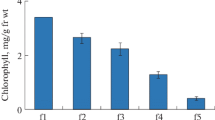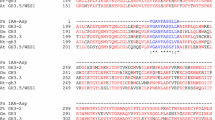Summary and Conclusions
A study has been made of the amino-acid changes taking place during protein regeneration in seedlings ofDolichos biflorus, Phaseolus mungo andCicer arietinum.
The first metabolic change observed is the rapid solubilization and hydrolytic breakdown of the seed protein. The soluble nitrogen reaches a maximum within 24 hours of germination. This is followed by hydrolysis of protein and the conversion of the greater part of it into amino-acids and subsequently to amides. During seedling growth all amino-acid fractions decrease with the exception of the dicarboxylic acids and their amides. Both asparagine and glutamine increase to many times their initial values but the quantity of glutamine is in all cases much smaller than that of asparagine. From the conditions under which the plants were grown asparagine formation must be considered a normal stage in protein regeneration in plants.
The presence in the seedlings of a third amide in addition to asparagine and glutamine can be inferred from the following facts:
-
(1)
The amide N in the aqueous extracts of the seedlings is greater than can be accounted for by the sum of asparagine and glutamine amide N present.
-
(2)
Amides are present in excess of the dicarboxylic acids, especially inDolichos biflorus andPhaseolus mungo.
InDolichos biflorus andPhaseolus mungo asparagine accumulation takes place without a corresponding increase in dicarboxylic acids indicating the possibility of a conversion of glutamic acid into aspartic acid,
The strikingly rapid disappearance of arginine observed in some of the seedlings suggests that this amino-acid plays a special role as a precursor of amides.
Similar content being viewed by others
References
BaileyBiochem. J., 1937,31, 1396.
ChibnallProtein Metabolism in Plants, Yale University Press, 1937.
Chibnall and WestallBiochem. J., 1932,26, 122.
Damodaran and VenkatesanProc. Ind. Acad. Sci., 1941,13, 345.
Hanke and KoesslerJ. Biol. Chem., 1920,43, 527.
Krishnan and KrishnaswamyBiochem. J., 1939,33, 1284.
MothesPlanta, 1929,1, 472.
Parnas and KlisieckiBiochem. Z., 1926,173, 227.
Pollard and ChibnallBiochem. J., 1934,28, 326.
PrianischnikowLand. Vers. Sta., 1899,52, 137.
TompsettBiochem. J., 1931,25, 2014.
Vickery, Pucher, Clark, Chibnall and WestallBiochem. J., 1935,29, 2710.
Author information
Authors and Affiliations
Rights and permissions
About this article
Cite this article
Damodaran, M., Ramaswamy, R., Venkatesan, T.R. et al. Amide synthesis in plants. Proc. Indian Acad. Sci. 23, 86–99 (1946). https://doi.org/10.1007/BF03049831
Received:
Issue Date:
DOI: https://doi.org/10.1007/BF03049831




